- Watercolor
paint blocks were invented by brothers William and Thomas Reeves
in the 1760' -1770s (see their early blocks below)
-
- In 1835 Winsor
& Newton introduced the first moist watercolor cakes using
glycerine They were more easily wettable making easier to use.
-
- This and
the new colors being invented by chemists & introduced contributed
to the watercolour painting craze in Victorian England.
-
- Queen Victoria
& Prince Albert were great patrons of the arts encouraged
the arts through many programs; especially by expanding the royal
warrants- providing a guarantee of quality of many brands of
art supplies.
-
ARZONE antique
watercolor cakes c. 1830
 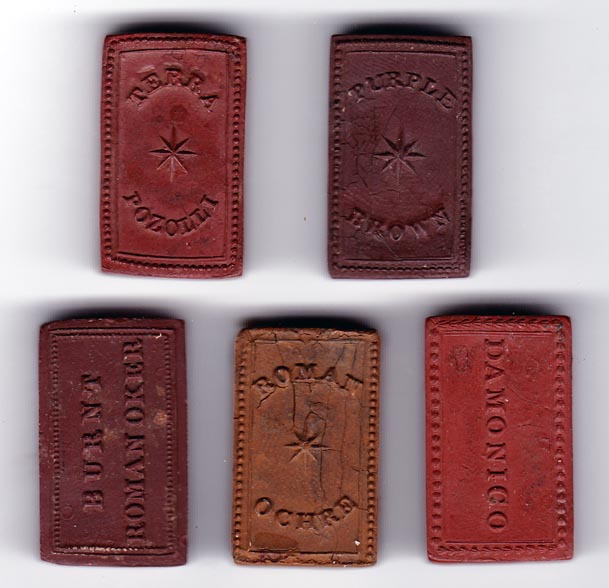
-
- Embossing on one block:
" 54 Dean St, Soho" he was at that address 1830-37
-
-
- The photos shows
both sides of same blocks .
- The colors appear slightly
different due to lighting.
-
-
- Blocks are approximately 1 inch long , 5/8 inch
wide & 1/4 inch thick.
- Photos are enlarged for detail 3/1
- As
with any modern professional artist's paints, they may contain
harmful substances. These should be handled with care. They are
not for use by children.
|
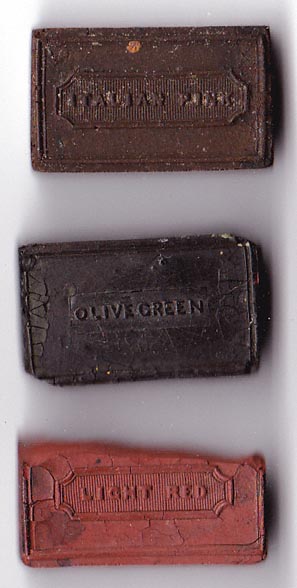 Waring & Dimes Antique Paint
Blocks Waring & Dimes Antique Paint
Blocks
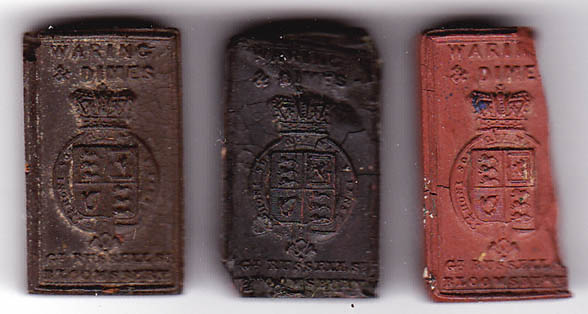
-
-
- Embossing on the block: "
Gt.Russell St .. Bloomsbury"
-
- The partnership dates these
blocks to 1840-1842
-
- The photos shows both sides
of same blocks .
- The colors appear slightly different
due to lighting.
-
- Early watercolor cakes of
this make are quite rare
- They also provided Drawing materials,Oil
colors, canvas & other supplies.
- JMW Turner was known to use
some of their art supplies.
-
- Blocks are approximately 1 inch long , 5/8 inch
wide & 1/4 inch thick.
- Photos are enlarged for detail 3/1
- As with any
modern professional artist's paints, they may contain harmful
substances. These should be handled with care. They are not for
use by children.
|
T. J. Morris Antique
Paint Blocks
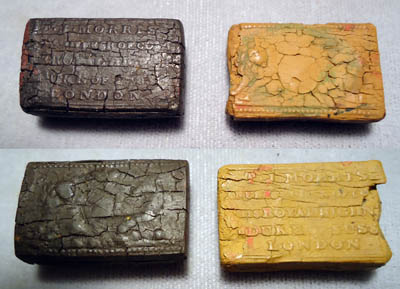 Early
watercolor cakes of this make are quite rare Early
watercolor cakes of this make are quite rare
- He was known to be a color maker 1818
to 1838
- In that period he USA color maker to the
Duke of Sussex from 1823 to 1838
- & to Her Majesty & Princes Victoria
1828 -1838
-
- This dates these blocks are
from 1823 to 1838
-
- Embossing on the block:
- T. J. Morris
- Manufacturer of Color
- to Royal.....
- ?? Duke of Sussex
- LONDON
-
- The combined photo shows
both sides of two blocks vertically.
- The colors appear slightly
different due to lighting.
-
- Blocks are approximately 15/16 inch long , 9/16
inch wide & 3/16 inch
thick.Photo is enlarged for detail 3/1
- As with any
modern professional artist's paints, they may contain harmful
substances. These should be handled with care. They are not for
use by children.
|
-
-
-
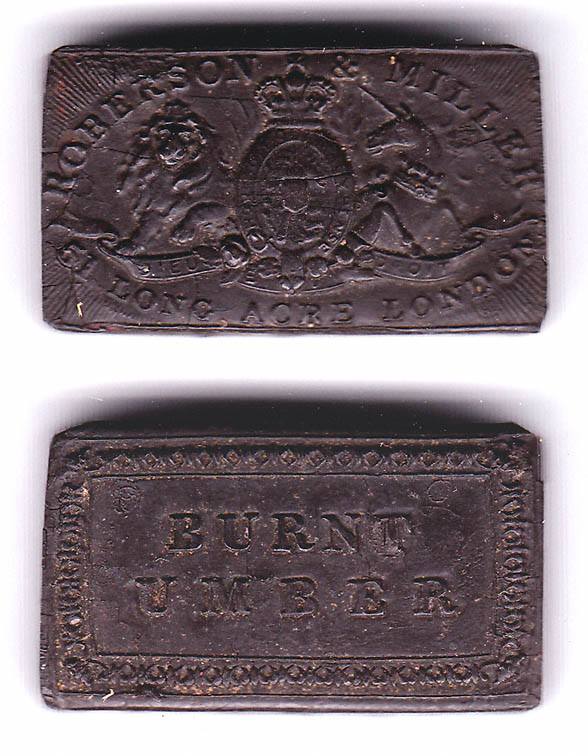
- Robertson & Miller
Paint Block -dating in the 1830's
- The photos shows
both sides of same blocks .
- Blocks are approximately 1 inch long , 5/8 inch
wide & 1/4 inch thick.
- Photos are enlarged for detail
-
|
-
-
-
-
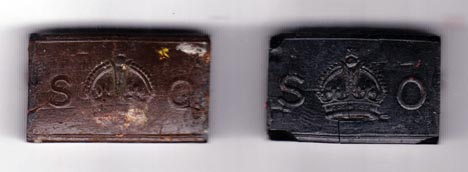
- Watercolor Paint
Blocks 1800's Marked "S O" with a crown.
- This stands for the
Crown Stationary Office in the UK.
- Goverment office
artists were issued materials with the SO stamp throughout the
empire.
-
- The paints were manufactured
by various London colormen and were fine quality.
- The Crown Stationary
Office was formed around 1822
-
-
-
- We will post more on these in time. For now our thanks
to a correspondant for this information.
-
-
-
-
- photo enlarged for detail
|
-
-
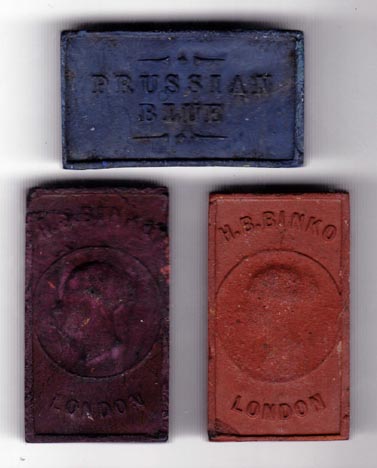
-
-
-
- H B Binko - London Antique
Paint Block c.1800's
-
-
- Henry Boch Binko (c.1838-1911), born Austria, was active
in London from 1868
- known in 1873 to be at 183, City-road, London
- Manufacturer and retailer of Paint, Stationery , Writing
equipment & Toys
-
-
-
-
-
-
- photo enlarged for detail
-
-
-
-
- References found:
- THE LONDON GAZETTE, JANUARY 24, 1873, Page
334
384* Binko, H. B. (*see also Gr.X, No. 384) Writing articles
183, City-road, London
-
- THE PRACTICAL MECHANIC'S JOURNAL. 23 12/A
February 1869.
439 H. B. Binko, Manufacture and application of indigo, carmine,
and other colours
|
-
-
 Winsor
& Newton Winsor
& Newton
Antique Paint
Blocks
pre 1881
Blocks are approximately 1 1/8 x 5/8 by 3/16 inch thick
photo enlarged for detail
NOT FOR SALE
I want blocks like these will trade or buy
c. 2010 R
M Bodoh
|
-
-
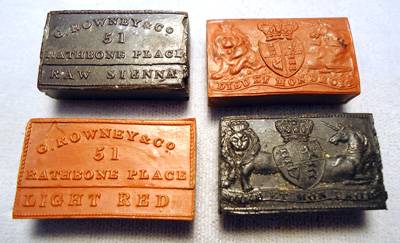 George
Rowney & Co George
Rowney & Co
- Antique Paint Block c.1844
c
-
-
-
-
-
- NOT FOR SALE
- Blocks are approximately 1 1/8 x 5/8 by 3/16 inch thick
- photo enlarged for detail
|

Newman's
Watercolor
Paint Blocks
1800's
Blocks are approximately 1 1/8 x 5/8 by 3/16
inch thick
photo enlarged for detail
NOT FOR SALE
|
-

- R Ackermann Paint
blocks- photo enlarged for detail. Blocks are around 1827- Shown
here on the back of a R Ackermann palette.
-
-
-
-
-
-
-
-
- DESIGNS OF THOMAS
REEVES & DESCENDANTS
- WATERCOLOR PAINT
BLOCKS THROUGH TIME
NOT FOR SALE -
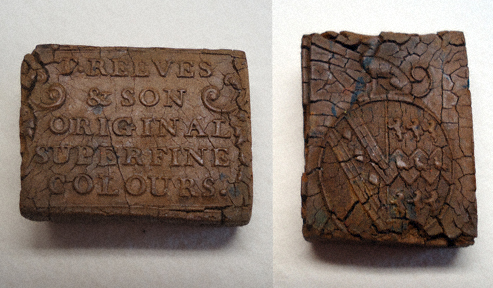
T Reeves & Son
(Thomas Reeves
with is son William J.
Reeves)
c 1784 1790
Note the shield is a oval
unlike the shield below.
-
-
-
-
-
-
-
-
-
-
 T
. Reeves & Son T
. Reeves & Son
- With the royal warrant
- ( Thomas Reeves with is son William J.
Reeves)
- a later variation of
- Thomas Reeves & Son paint blocks
- c 1790-1799
-
-
-
-
-
-
-
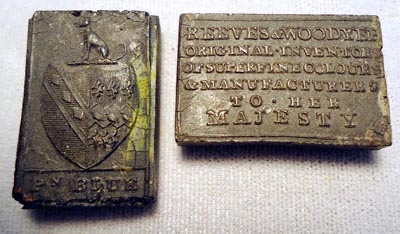
-
-
- Reeves & Woodyer
- (son of Thomas: William J Reeves &
Partner Woodyer)
- c. 1799-1817
-
- Son of Thomas reeves: William J.Reeves should not be confused
with Uncle: William- brother of Thomas- see above
-
-
-
-
-
-
- Reeves & Woodyer & Reeves not
shown-
- (Partners : William J Reeves- Woodyer
& his son) around 1817-
1818
-
-
-
-
- Reeves & Son(William J Reeves-&
his son)c.1819-1826 not shown
-
 Reeves
& Sons Reeves
& Sons
- (The two sons of the late William J
Reeves carrying on the business with fathers name)
- 1827-
-
- On these particular blocks
- Were these "New Wax Colors"
a response to Winsor & Newton introducing
- Moist watercolors?
-
- Was what they called wax actually glycerine
or a water based wax?
-
-
-
-
-
-
-
-
-
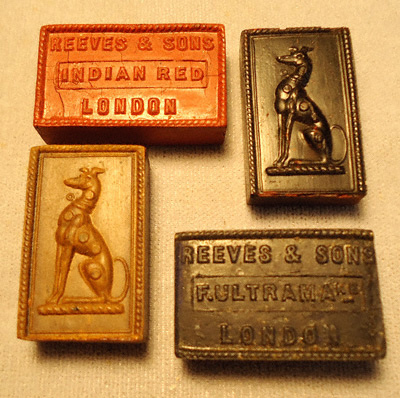
-
Reeves & Sons
by this time is was
a company of various owners
c.1860-
similar Blocks may be earlier
-
-
-
-
-
-
-
-
-
-
-
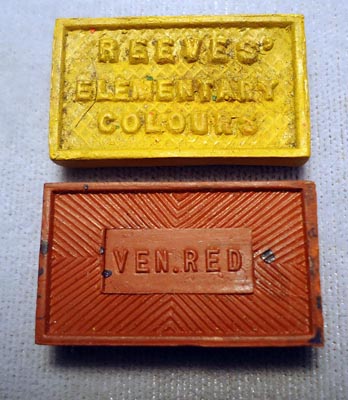
- Reeves & Sons
- Superior Elementary Colors line
- a company of various owners
- 1880?-1899
-
-
-
-
-
-
- Reeves & Sons Ltd c.1891- 1972
- (not shown
-
-
-
- Blocks are approximately 1 1/8 x 5/8 by 3/16 inch thick
- photo enlarged for detail
|
-
- Curious case of Antique
REEVES Paint Block
- 1700's
-
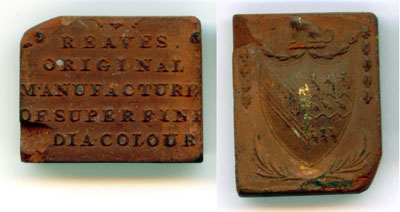 Does the paint block on the left have
a misspelling ReAves of REEves? Does the paint block on the left have
a misspelling ReAves of REEves?
-
- The text is similar to blocks
dating c 1784 1790,
- but the front design is similar
to blocks dating 1790-1799
- though it is wider (below
right).
-
- It is most probably an early
forged paint block by another maker
- Forgeries if Reeves paints
were known of as early as the late 1700's.
-
-
-
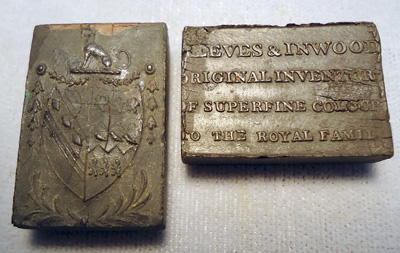
-
- It was found in a British
paint box from the 1780's by William Reeves along with other
paint blocks from England, France and Germany.
-
- We believe the box has been
in America since the 1700's
- it seems to tell the story
of having to resupply the British box with paint from other countries
during the Revolutionary War and the War of 1812.
|
-
-
- DESIGNS OF WILLIAM
REEVES WATERCOLOR PAINT BLOCKS THROUGH TIME
NOT FOR SALE
- s

-
- William Reeves Paint block -- 1784-1795
-
- William Reeves was the brother of Thomas
Reeves and formed two separate Reeves paint companies when their
partnership broke up in 1773.
-
-
-
-
-
-
-
-
-
-
-
-
 Reeves
& Inwoodc. 1796-1811 Reeves
& Inwoodc. 1796-1811
( William Reeves {Brother
of Thomas} & Inwood as Partner
in a separate parallel
business
after brothers Thomas and
William broke up their partnership in 1784)
-
|
-
Caution: Antique paint
blocks like modern paint may have some harmful substances in
them
& should be handled carefully and not ingested through the
mouth or skin. They are not for use by children.
-
-
- PAINT PALETTES
c. 1700's -1800's
- The palettes below
are not for sale
-
-
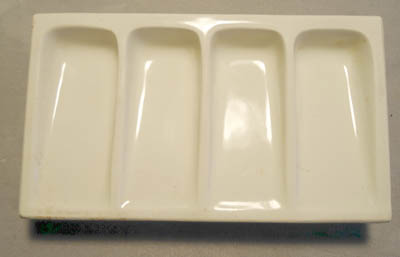 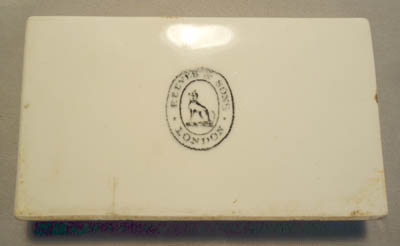
-
- Reeves & Sons
1829 on
- 4 5/8 inch by 2 1/2
inch wide
-
-
- Artists supplies
c. 1700's -1800's
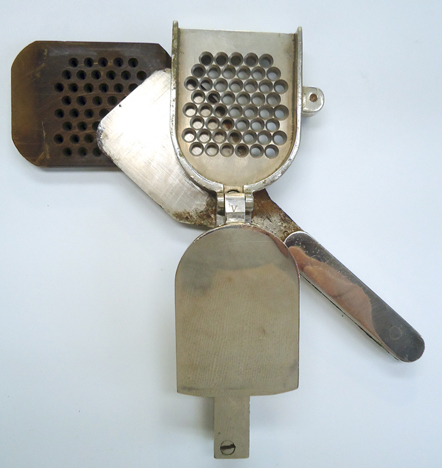
- W.Reeves &
CO Pigment Sifter
- above showing
all the layers
- below the engraved
name
- note this probably
is made by a different Reeves company than the Paint makers.
-
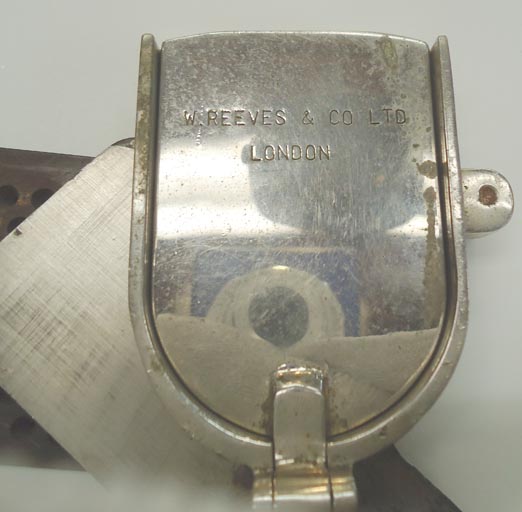
-
-
-

- Conte' crayon- or
chalk holder- silver
- This device easily
holds the square crayons for ease of drawing and allowing the
artist to use the whole arm for more elegant strokes.
- The rings slid out
to cinch the crayon tightly. shown enlarged for detail. Actual
size approximately 6 inches long without crayons:
-
- Below is one in brass
slightly under 6 inches.

|